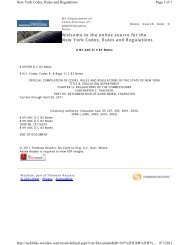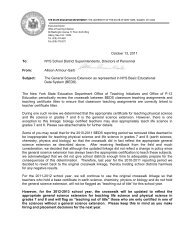ESL Learning Standards - Higher Ed - New York State Education ...
ESL Learning Standards - Higher Ed - New York State Education ...
ESL Learning Standards - Higher Ed - New York State Education ...
You also want an ePaper? Increase the reach of your titles
YUMPU automatically turns print PDFs into web optimized ePapers that Google loves.
Students learning English as a second language will use English for self-expression, artistic creation,<br />
and participation in popular culture. They will develop and use skills and strategies appropriate to<br />
their level of English proficiency to listen to, read, and respond to oral, written, and electronically<br />
produced texts and performances, relate texts and performances to their own lives and other<br />
works, and develop an understanding of the diverse social, historical, and cultural dimensions the<br />
texts and performances represent.<br />
Performance Indicators: See page 16<br />
Advanced<br />
Students complete Intermediate task. Teacher divides the<br />
class according to point of view. Each group discusses<br />
arguments for its point of view. Students hold a class<br />
debate, and teacher videotapes the debate. Class critiques<br />
the debate. Class may also develop rubric for evaluating<br />
debate techniques.<br />
Performance indicators: 1, 2, 3, 4, 5, 7, 9, 10, 11<br />
English Proficiency Level<br />
Transitional<br />
Students read The Three Little Pigs, The True Story of the<br />
Three Little Pigs, and Little Red Riding Hood. Pairs of students<br />
take turns role-playing a conversation in a diner<br />
between the wolves from the two stories. Teacher provides<br />
dialogue starters (e.g., “You won’t believe what happened<br />
to me...” “I am so frustrated because…”) and guidelines<br />
(e.g., express feelings, provide details of story, ask followup<br />
questions). After role-plays, students write dialogue<br />
between the three little pigs and Little Red Riding Hood for<br />
performance in another class.<br />
Performance indicators: 1, 2, 4, 5, 7, 9, 10, 11<br />
Students complete Intermediate task. They form two<br />
groups based on genre preference. Groups make list of<br />
characteristics of their genre. Groups present an argument<br />
for their preference, using the characteristics of the genre<br />
as support. Lists of genre characteristics are posted on bulletin<br />
board for future reference.<br />
Performance indicators: 1, 2, 3, 4, 7, 10, 12<br />
As a whole class, students maintain a chart of examples of<br />
various literary elements from texts along with titles that<br />
they read or hear throughout the year.<br />
Performance indicators: 1, 3, 4, 12<br />
Students complete Advanced task. With a partner, students<br />
write a persuasive letter to the school librarian or editor of<br />
the school paper. They might argue for a stronger emphasis<br />
on one of the two genres represented in school literary<br />
publications or in the school library.<br />
Performance indicators: 1, 2, 3, 4, 7, 10, 12<br />
Students individually choose a reading of fiction and identify<br />
examples of literary elements on an individual chart or<br />
in their reading logs. They compare the use of these elements<br />
in their individual reading to the use of the elements<br />
in the text read by the whole class during class discussions<br />
or in reading circles.<br />
Performance indicators: 1, 3, 4, 11, 12<br />
<strong>ESL</strong><br />
2<br />
Interm<br />
Students complete Intermediate task. They select a fable<br />
from their culture to present to the class, and illustrate four<br />
critical scenes from the fable for presentation. They practice<br />
presentation with <strong>ESL</strong> classmates and when ready, formally<br />
present the fable to other small groups (e.g., younger students,<br />
invited guests).<br />
Performance indicators: 1, 3, 5, 6, 7<br />
Students complete Intermediate task. They critically analyze<br />
the elements of the genre (moral, animal messenger). They<br />
each write an original fable, selecting an animal and a<br />
problem, and they publish a class anthology of fables.<br />
Performance indicators: 1, 3, 5, 7, 8, 10, 11, 12<br />
Continued on next page<br />
CLASSROOM<br />
TASKS<br />
Sample Classroom Tasks 73
















